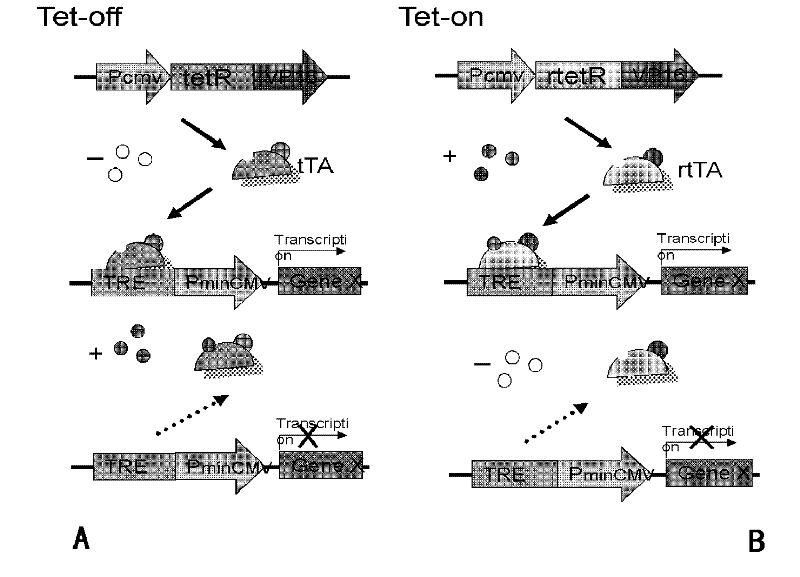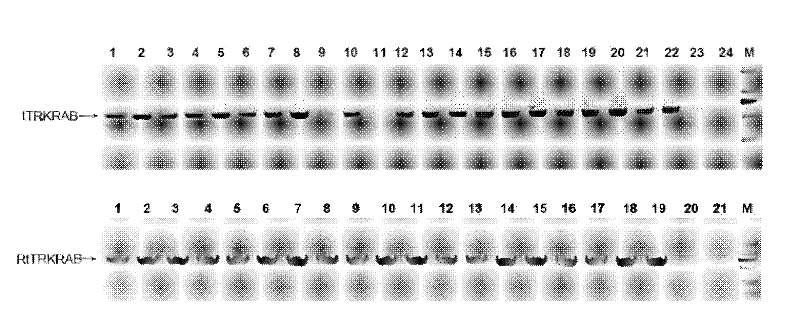Genetic modification method for regulating and controlling animal endogenous gene expression
An endogenous gene and animal technology, applied to cells modified by introducing foreign genetic material, biochemical equipment and methods, and microbial measurement/testing, etc., can solve problems such as functional loss, lethality, and unclearness
- Summary
- Abstract
- Description
- Claims
- Application Information
AI Technical Summary
Problems solved by technology
Method used
Image
Examples
Embodiment 1
[0089] Construction of tTR-KRAB and RtTR-KRAB transgenic plasmids driven by CAG promoter
[0090] The construction process of pcDNA3-CAG promoter-tTR-KRAB expression plasmid is as follows:
[0091] 1) pcDNA3.1(-)-Hygromycin (purchased from Invitrogen) was double-enzymatically digested with BglII and NheI to remove the original CMV promoter, filled in and ligated, and then used as a vector after double-digested with XbaI and BamHI to prepare for ligation into CAG promoter;
[0092] 2) SpeI and BamHI double digestion of PLVCT-tTR-KRAB or PLVCT-RtTR-KRAB plasmid (purchased from addgene company) to obtain the CAG promoter fragment;
[0093] 3) Ligate the vector fragment in 1) with the CAG promoter in 2) to obtain the pcDNA3.1(-)-Hygromycin-CAG promoter vector, which is double-cut with BamHI and KpnI, and then combined with PCR (using PLVCT-tTR- KRAB or PLVCT-RtTR-KRAB plasmid as a template) tTR-KRAB or RtTR-KRAB (also known as tTR-KRAB / RtTR-KRAB) fragments obtained after digesti...
Embodiment 2
[0095] Preparation of tTR-KRAB and RtTR-KRAB transgenic mice driven by CAG promoter
[0096] After the pcDNA3-CAG promoter-tTR-KRAB / RtTR-KRAB plasmid was digested with BciVI and EcoRI, the fragments containing CAG promoter-tTR-KRAB-polyA and CAGpromoter-RtTR-KRAB-polyA were recovered by tapping rubber, and passed through fertilized egg cell male prokaryotic DNA Transgenic Founder mice were obtained by microinjection (for the preparation of Founder mice, see Gordon K, Ruddle FH.1986. Genetransfer into mouse embryos. Dev Biol (NY1985) 4: 1-36. Kupriyanov S, Zeh K, Baribault H.1998. Double pronuclei injection of DNA into zygotes increases yields of transgenic mouse lines. Transgenic Res 7:223-226).
[0097] A total of 101 mice were born by microinjection of CAG promoter-tTR-KRAB-polyA fragment, and 20 transgenic positive mice were identified by PCR twice; 19 transgene-positive mice were identified by two PCR tests. PCR identification results such as image 3 shown.
Embodiment 3
[0099] Construction of Nmyc-TRE-EGFP-Knockin targeting vector
[0100] Use ET-Clone technology to obtain the target targeting vector through two-step homology arm extraction. The steps are as follows: first, four homologous small arms a, b, c and d (which are respectively located at the 5' end of the 5' arm of the targeting vector) are obtained by PCR from Nmyc BAC (purchased from Gene Service Company, UK) with a length of 200-400 bp. ' end, 3' end of the 3' arm, 3' end of the 5' arm and 5' end of the 3' arm). The primers used are listed in Table 1.
[0101] Table 1
[0102]
[0103] Then connect a and b into pBR322-MK in the correct direction (see Pentao Liu, Nancy A. Jenkins and Neal G. Copeland. A Highly Efficient Recombineering-Based Method for Generating Conditional Knockout Mutations. Genome Res. 2003 13: 476-484) SalI and SpeI; between the SpeI and BamHI sites, after SpeI linearization at the junction of a and b, the two extract a 14.78kb DNA fragment from Nmyc BA...
PUM
 Login to View More
Login to View More Abstract
Description
Claims
Application Information
 Login to View More
Login to View More - R&D
- Intellectual Property
- Life Sciences
- Materials
- Tech Scout
- Unparalleled Data Quality
- Higher Quality Content
- 60% Fewer Hallucinations
Browse by: Latest US Patents, China's latest patents, Technical Efficacy Thesaurus, Application Domain, Technology Topic, Popular Technical Reports.
© 2025 PatSnap. All rights reserved.Legal|Privacy policy|Modern Slavery Act Transparency Statement|Sitemap|About US| Contact US: help@patsnap.com



